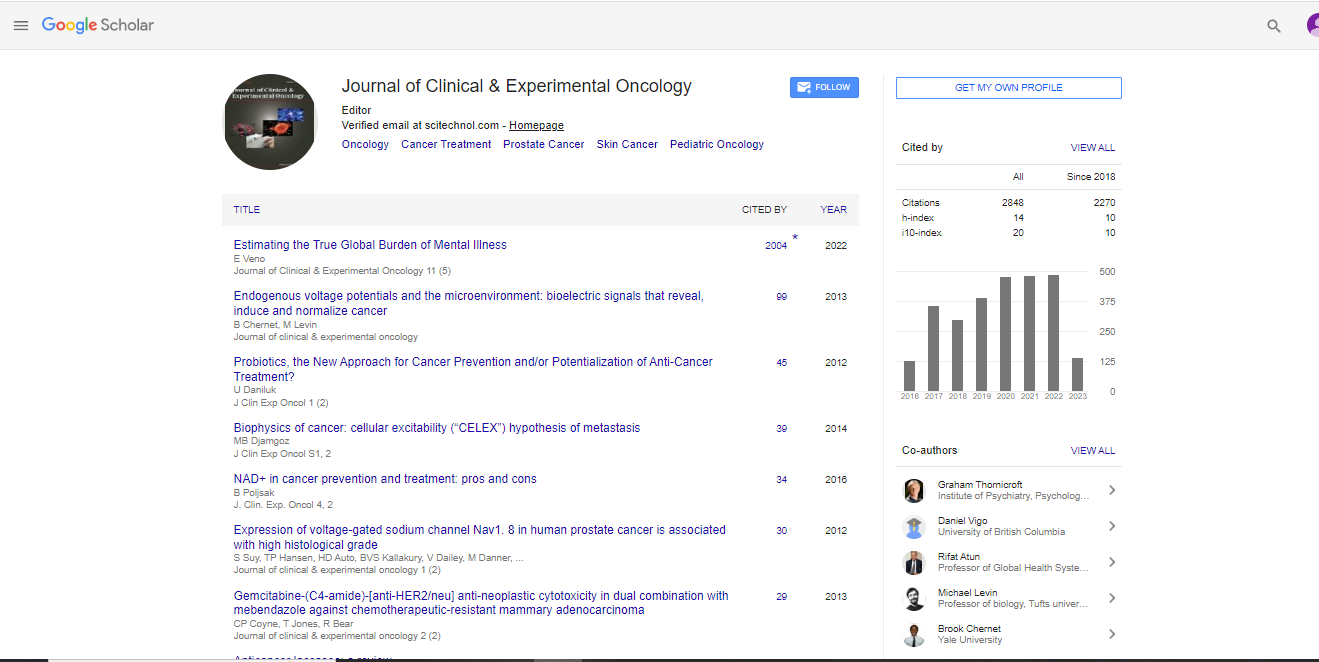Commentary, J Clin Exp Oncol Vol: 13 Issue: 2
Examining Skin Cancer Causes, Diagnosis and Effective Prevention
Parensa Noicile*
1Department of Oncology, Eberhard Karls University, Tuebingen, Germany
*Corresponding Author: Parensa Noicile,
Department of Oncology, Eberhard Karls
University, Tuebingen, Germany
E-mail: parensa_noicile@kar21.de
Received date: 22 May, 2024, Manuscript No. JCEOG-24-143931;
Editor assigned date: 24 May, 2024, PreQC No. JCEOG-24-143931 (PQ);
Reviewed date: 07 June, 2024, QC No. JCEOG-24-143931;
Revised date: 14 June, 2024, Manuscript No. JCEOG-24-143931 (R);
Published date: 21 June, 2024, DOI: 10.4172/2324-9110.1000416
Citation: Noicile P (2024) Examining Skin Cancer Causes, Diagnosis and Effective Prevention. J Clin Exp Oncol 13:2.
Description
Skin cancer is one of the most common forms of cancer worldwide, with millions of new cases diagnosed annually. While it is largely preventable and highly treatable when caught early, understanding its causes, methods of diagnosis, and effective prevention strategies is crucial for safeguarding skin health. It explores these aspects in detail, aiming to provide a thorough overview. Skin cancer primarily arises from abnormal growth of skin cells, often due to damage from Ultraviolet (UV) radiation. The two main types of skin cancer are nonmelanoma and melanoma. Non-melanoma skin cancers, which include Basal Cell Carcinoma (BCC) and Squamous Cell Carcinoma (SCC), are more common and generally less dangerous than melanoma. Melanoma, on the other hand, is less common but more aggressive and can spread to other parts of the body.
The primary cause of skin cancer is prolonged exposure to UV radiation from the sun. UV radiation damages the DNA in skin cells, which can lead to mutations and the development of cancer. Tanning beds and sunlamps also emit UV radiation and contribute to the risk. Genetics play a significant role in skin cancer risk. Individuals with a family history of skin cancer or specific genetic mutations, such as those in the BRCA1 or BRCA2 genes, may have a higher predisposition to developing the disease. People with fair skin, light hair, and light eyes are more susceptible to skin cancer. This is because their skin has less melanin, which provides some protection against UV radiation.
Geographic location and environmental factors, such as high altitude and proximity to the equator, can increase UV exposure. Additionally, exposure to certain chemicals and substances, like arsenic, may also contribute to skin cancer risk. Early detection of skin cancer is vital for effective treatment. The diagnosis typically involves a combination of visual examination and biopsy. A dermatologist will perform a thorough skin examination to identify any suspicious lesions or changes in existing moles. Key signs to look for include asymmetry, irregular borders, uneven coloration, and changes in size or texture of moles.
If a uncertain area is identified, a biopsy is usually performed to confirm the diagnosis. During a biopsy, a small sample of the skin is removed and examined under a microscope. There are several types of biopsies, including punch biopsy, shave biopsy, and excisional biopsy, each serving different purposes based on the suspected type and stage of cancer. Preventing skin cancer largely revolves around reducing UV exposure and adopting protective measures. Regular application of broad-spectrum sunscreen with an SPF of 30 or higher can protect the skin from harmful UV radiation. Sunscreen should be applied generously and reapplied every two hours, or more frequently if swimming or sweating. Wearing protective clothing, such as longsleeved shirts, wide-brimmed hats, and sunglasses, can shield the skin from UV rays. Specialized clothing with UV Protection Factors (UPF) provides additional protection.
Tanning beds and sunlamps emit UV radiation that increases the risk of skin cancer. Avoiding these devices is essential for reducing skin cancer risk. Limiting sun exposure, especially between the hours of 10 am and 4 pm. when UV rays are strongest, can help reduce risk. Seeking shade, especially during peak sunlight hours, provides an additional layer of protection. Regular self-exams and annual visits to a dermatologist for professional skin checks can help detect skin cancer early. Familiarizing oneself with the appearance of normal moles and spots can aid in recognizing any changes that may need medical attention. A healthy diet rich in antioxidants, vitamins, and minerals can support overall skin health. Staying hydrated and avoiding smoking also contribute to maintaining healthy skin.
Conclusion
Skin cancer remains a significant public health concern, but understanding its causes, diagnosis, and prevention can significantly reduce the risk and impact of the disease. By adopting effective sun protection measures, staying attentive about skin changes, and seeking regular medical check-ups, individuals can take proactive steps to protect themselves from skin cancer. With continued awareness and preventive efforts, the incidence of skin cancer can be significantly reduced, leading to healthier skin and a better quality of life. By prioritizing sun safety and early detection, one can collectively work towards minimizing the impact of skin cancer and promoting overall skin health.
 Spanish
Spanish  Chinese
Chinese  Russian
Russian  German
German  French
French  Japanese
Japanese  Portuguese
Portuguese  Hindi
Hindi 



